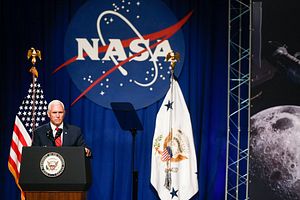Like so many things, U.S. President Donald Trump’s proposal to create a new branch of the American military – a Space Force – began as something of a joke. It was widely derided among the U.S. national security cognoscenti until, like so many things, it snowballed into something with legs. Even if we still don’t know what exactly the proposed Space Force will be, it has turned into a cri de coeur for Trump and many of his supporters.
The United States won’t operate this new force any time soon, but Trump’s proposal has sparked a great debate on the merits of the idea. The facts should be apparent, but aren’t. First, the United States Air Force already covers space as one of its domains; a U.S. Air Force Space Command already exists. Second, the bureaucratic overhead and ensuing red tape would likely, in the short term at least, prove deleterious to U.S. efforts in space.
Third, if there’s an obvious short-term beneficiary of a Space Force, it’s the U.S. defence industry, which would no doubt find itself inundated with new contracts for space-related military materiel. Fourth, sustained Space Force talk is likely to spur U.S. adversaries, including China and Russia, to accelerate their own efforts to explore creative uses of space to gain an advantage in a future armed conflict.
This final point has been cited by some proponents of a dedicated U.S. space branch. But there’s nothing about China and Russia that would require the United States to overhaul its military bureaucracy. American intelligence agencies are clear on the parallel and ongoing development of a range of weapons that make use of “space” – the vacuum outside the earth’s atmosphere, which hosts, among other things, U.S. military satellites.
“We assess that, if a future conflict were to occur involving Russia or China, either country would justify attacks against U.S. and allied satellites as necessary to offset any perceived U.S. military advantage derived from military, civil or commercial space systems,” said a report published this year by the U.S. director of national intelligence, Dan Coats.
“Of particular concern, Russia and China continue to launch ‘experimental’ satellites that conduct sophisticated on-orbit activities, at least some of which are intended to advance counterspace capabilities,” it continued.
If the United States is concerned about counterspace capabilities in Russia and China – as it should be – the answer is not to create a Space Force, but to pursue arms control creatively with Moscow and Beijing. The United States today is the world’s foremost space superpower; U.S. intelligence, surveillance and reconnaissance capabilities rely on the largest military satellite network and – make no mistake – U.S. war planners would have the most to lose from the proliferation of counterspace weapons in the Russian and Chinese arsenals.
Just in the past year, both China and Russia have tested hit-to-kill weapon systems, which are surface-launched missiles designed to ram U.S. satellites, destroying them with sheer kinetic energy. In 2007, China made its interests in these weapons known by irresponsibly shooting down one of its own defunct satellites, creating a hazardous space debris cloud that will threaten other satellites for decades to come. With Russian and Chinese developmental activity, the U.S. priority should be to clamp down on the unconstrained development of counterspace weapons. Even beyond hit-to-kill weapons, the kinds of in-orbit systems described by U.S. intelligence agencies should also be of concern.
The instinct driving calls for a Space Force, however, makes precisely the opposite recommendation. It is a call to arms and, consequently, a call to an arms race. Even as the United States may need to “do more” in space to manage emerging threats, the prescription for the years ahead is not a new branch as Trump imagines it. U.S. Vice-President Mike Pence recently pointed out that China’s creation of the PLA Strategic Support Force, which is charged with developing and maintaining the PLA’s space capabilities, necessitates a similar U.S. move. This is a poor justification too; bureaucratic mirror-imaging is not the solution the United States needs.
Fortunately, reality appears to be getting in the way of Trump’s poorly specified plans. The recently approved U.S. defence budget contains a range of new space war fighting proposals, including one to create a subordinate command under U.S. Strategic Command, which already deals in the space domain, to coordinate activities in space among the existing U.S. services. The U.S. secretary of defence is also now charged with coming up with a new “space war-fighting policy” by early next year.
Make no mistake: the salience of space as a war-fighting domain won’t be diminishing any time soon – at least not without a concerted effort at good faith arms control, which appears to be unlikely. But in the meantime, Americans must fully consider the right way to proceed. The Space Force likely won’t be it.
This article originally appeared at the South China Morning Post. It is republished here with kind permission.

































